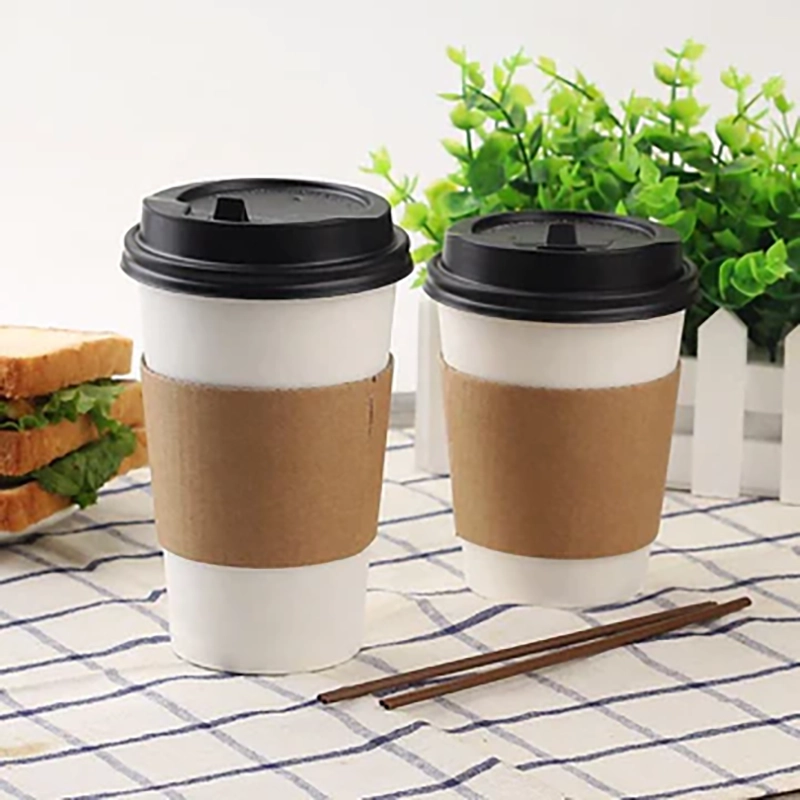اختيار الأكواب المستدامة للشركات

ما هي الأكواب المستدامة؟ خامات الأكواب المستدامة هي مواد مسؤولة بيئياً تُستخدم في الأكواب والعبوات التي تستخدم لمرة واحدة، وهي مصممة لتقليل الأثر البيئي.
تُعد مخازن الأكواب المستدامة أمرًا بالغ الأهمية لأي شركة مهتمة بالبيئة تتطلع إلى الحد من التأثير البيئي من خلال خيارات التغليف المسؤولة.
فهم أهمية مخزون الكوب المستدام
أكواب مستدامة يشير إلى مواد الأكواب التي يتم إنتاجها باستخدام ممارسات ومواد صديقة للبيئة. وهي تأخذ في الاعتبار دورة حياة الكوب بأكملها، بدءًا من مصادر المواد الخام وحتى التخلص منها. إن اختيار مواد الأكواب الصديقة للبيئة أمر بالغ الأهمية لأن مواد الأكواب التقليدية، مثل البوليسترين والبلاستيك، لها تأثير ضار على البيئة. هذه المواد مشتقة من الوقود الأحفوري وغير قابلة للتحلل البيولوجي، مما يؤدي إلى تلوث ونفايات طويلة الأمد.
تحديد الأثر البيئي للأكواب التقليدية
تقليدي المواد المستخدمة في صناعة الأكواب مثل البوليسترين والبلاستيك لها تأثير بيئي كبير التأثيرات. يُشتق البوليسترين من البترول، وهو مورد غير متجدد، ويطلق إنتاجه غازات الدفيئة الضارة في الغلاف الجوي. وبالإضافة إلى ذلك، تستغرق أكواب البوليسترين مئات السنين لتتحلل، مما يساهم في نفايات مدافن النفايات. أما الأكواب البلاستيكية، من ناحية أخرى، فهي مصنوعة من مواد بلاستيكية تعتمد على البترول ولا تتحلل بيولوجيًا على الإطلاق. فهي تتحلل إلى مواد بلاستيكية دقيقة أصغر حجماً يمكن أن تلوث مصادر المياه وتضر بالحياة البحرية.
كما أن لعملية تصنيع الأكواب التقليدية عواقب بيئية سلبية. حيث يتطلب استخراج المواد الخام ومعالجتها كميات كبيرة من الطاقة والمياه، مما يساهم في انبعاثات الكربون وتلوث المياه. وعلاوة على ذلك، غالبًا ما تنطوي عملية التخلص من مخلفات الأكواب التقليدية على الحرق أو الطمر، وكلاهما يطلق ملوثات ضارة في الهواء أو التربة.
استكشاف فوائد الكوب المستدام لأعمالك التجارية
| فوائد مخزون الكوب المستدام | الوصف |
|---|---|
| الأثر البيئي | تقليل النفايات والبصمة الكربونية |
| وفورات في التكاليف | انخفاض تكاليف الإنتاج والحوافز الضريبية المحتملة |
| صورة العلامة التجارية | يعزز السمعة ويجذب العملاء المهتمين بالبيئة |
| الامتثال التنظيمي | يفي باللوائح الحكومية ويتجنب الغرامات |
| ولاء العملاء | يعزز ولاء العملاء ويزيد من تكرار الأعمال التجارية |
يوفر اختيار الأكواب القابلة للتحويل إلى سماد فوائد عديدة للشركات. أولاً، إنه يدل على الالتزام بالمسؤولية البيئية، وهو ما يمكن أن يعزز سمعة الشركة ويجذب العملاء المهتمين بالبيئة. كما أن للأكواب القابلة لإعادة التدوير تأثير إيجابي على البيئة من خلال تقليل انبعاثات الكربون والحفاظ على الموارد الطبيعية وتقليل النفايات.
وعلاوة على ذلك، يمكن أن يؤدي استخدام الكوب المتجدد إلى وفورات محتملة في التكاليف بالنسبة للشركات. في حين أن التكلفة الأولية كأس مستدام قد تكون أعلى قليلاً من الخيارات التقليدية، إلا أن التوفير على المدى الطويل قد يكون كبيراً. على سبيل المثال، تُصنع بعض مواد الأكواب المستدامة من موارد متجددة أكثر فعالية من حيث التكلفة على المدى الطويل. بالإضافة إلى ذلك، يمكن للشركات تقليل تكاليف إدارة النفايات عن طريق اختيار المواد التي يمكن إعادة تدويرها أو تحويلها إلى سماد بسهولة.
النظر في فعالية الكوب المستدام من حيث التكلفة
عند مقارنة تكلفة مخزون الأكواب المستدام بالخيارات التقليدية، من المهم مراعاة الفوائد المالية طويلة الأجل. في حين أن تكلفة المواد الخام المستدامة قد تكون أعلى قليلاً في البداية، يمكن للشركات توفير المال على المدى الطويل من خلال تقليل تكاليف إدارة النفايات وتوفير الطاقة المحتمل. بالإضافة إلى ذلك، تُصنع بعض مواد خامات الأكواب المستدامة من موارد متجددة قد تصبح أكثر فعالية من حيث التكلفة مع زيادة إنتاجها.
وتجدر الإشارة أيضًا إلى أن تكلفة خامات الأكواب التقليدية قد ترتفع في المستقبل بسبب اللوائح التنظيمية الأكثر صرامة بشأن المواد البلاستيكية أحادية الاستخدام وزيادة الطلب على البدائل المستدامة. من خلال الاستثمار في مخزون الأكواب المستدام الآن، يمكن للشركات أن تحمي عملياتها في المستقبل وتتجنب الارتفاعات المحتملة في الأسعار المرتبطة بالخيارات التقليدية.
تقييم متانة وأداء أكواب الأكواب المستدامة
أحد الشواغل التي قد تساور الشركات عند التفكير في استخدام الأكواب المستدامة هو متانتها وأدائها مقارنةً بالخيارات التقليدية. ومع ذلك، فقد قطعت مواد الأكواب المستدامة شوطًا طويلاً من حيث الجودة والأداء الوظيفي. فقد صُممت العديد من خيارات خامات الأكواب المستدامة لتكون متينة وعملية مثل نظيراتها التقليدية.
على سبيل المثال، بعض مواد الأكواب المستدامة مبطنة بالبلاستيك الحيوي النباتي الذي يوفر عزلًا ممتازًا ويمنع التسرب. يمكن لهذه المواد أن تتحمل درجات الحرارة الساخنة والباردة دون المساس بسلامتها الهيكلية. بالإضافة إلى ذلك، أدت التطورات في تكنولوجيا الأكواب المستدامة إلى تطوير مواد مقاومة للشحوم والرطوبة، مما يجعلها مناسبة لمجموعة واسعة من تطبيقات الأغذية والمشروبات.
فحص مدى توافر مخزون الكوب المستدام في منطقتك
قد يتطلب العثور على خامات أكواب مستدامة في منطقتك بعض البحث والجهد، ولكن أصبح الوصول إليها متاحًا بشكل متزايد مع تزايد الطلب على التغليف المستدام. ابدأ بالتواصل مع موردي وموزعي التعبئة والتغليف المحليين للاستفسار عن خيارات مواد التغليف المستدامة. يقدم العديد من الموردين الآن مجموعة من البدائل الصديقة للبيئة، بما في ذلك أكواب مصنوعة من الورق المعاد تدويره أو المواد القابلة للتحلل الحيوي.
ومع ذلك، من المهم ملاحظة أن توافر خامات الأكواب المستدامة قد يختلف حسب موقعك. في بعض المناطق، قد تكون خيارات الأكواب المستدامة محدودة أو أكثر تكلفة بسبب التحديات اللوجستية أو انخفاض الطلب. في مثل هذه الحالات، يمكن للشركات أن تفكر في عقد شراكات مع الموردين المتخصصين في التغليف المستدام أو استكشاف الخيارات عبر الإنترنت التي توفر الشحن على مستوى البلاد.
البحث في الشهادات والمعايير الخاصة بالأكواب المستدامة
عند اختيار خامات أكواب مستدامة، من الضروري البحث والتحقق من الشهادات والمعايير المرتبطة بالمواد. تضمن شهادات مثل مجلس الإشراف على الغابات (FSC) ومبادرة الحراجة المستدامة (SFI) أن مواد الأكواب يتم الحصول عليها من غابات تدار بطريقة مسؤولة. وبالإضافة إلى ذلك، تضمن شهادات مثل معهد المنتجات القابلة للتحلل الحيوي (BPI) أو علامة شهادة المنتجات القابلة للتسميد (CMA) أن مواد الأكواب قابلة للتسميد في ظل ظروف محددة.
وللبحث عن هذه الشهادات، يمكن للشركات زيارة الموقع الإلكتروني لمنظمة الاعتماد المعنية أو التشاور مع خبراء التعبئة والتغليف المطلعين على معايير التغليف المستدام. من المهم التأكد من أن مواد التعبئة والتغليف تفي بمعايير الصناعة المعترف بها لتجنب الغسل الأخضر أو الادعاءات المضللة.
المقارنة بين الأنواع المختلفة من الأكواب المستدامة المتاحة
هناك أنواع مختلفة من الأكواب المستدامة المتاحة، ولكل منها مجموعة من المزايا والعيوب الخاصة بها. أحد الخيارات الشائعة هو الأكواب الورقية، والتي غالبًا ما تكون مصنوعة من ألياف ورقية معاد تدويرها أو من ورق بكر من مصادر مستدامة. يمكن إعادة تدوير الأكواب الورقية بسهولة ولها تأثير بيئي أقل مقارنةً بالأكواب البلاستيكية أو أكواب البوليسترين. ومع ذلك، فهي من المهم اختيار الورق أكواب مبطنة بمواد قابلة للتسميد أو قابلة لإعادة التدوير لضمان استدامتها.
الخيار الآخر هو الأكواب القابلة للتحلل الحيوي، وهي مصنوعة من مواد نباتية مثل نشا الذرة أو قصب السكر. تم تصميم هذه الأكواب لتتحلل بشكل طبيعي في مرافق التسميد، مما يقلل من تأثيرها على البيئة. ومع ذلك، من المهم ملاحظة ما يلي أكواب قابلة للتحلل قد لا تتحلل في ظروف مدافن النفايات العادية وتتطلب مرافق سماد معينة لتتحلل بشكل صحيح.
التشاور مع الخبراء في مجال التغليف المستدام
يمكن أن توفر الاستشارات مع الخبراء في مجال التغليف المستدام للشركات رؤى وتوجيهات قيّمة خلال عملية الانتقال. يمكن لخبراء التعبئة والتغليف مساعدة الشركات على تحديد أنسب خيارات التعبئة والتغليف المستدام بناءً على احتياجاتها ومتطلباتها الخاصة. ويمكنهم أيضًا تقديم معلومات عن أحدث التطورات في تكنولوجيا التغليف المستدام ومساعدة الشركات على اجتياز عمليات الاعتماد والتحقق.
للعثور على خبراء في التعبئة والتغليف المستدام، يمكن للشركات التواصل مع الجمعيات الصناعية أو حضور المعارض التجارية أو المؤتمرات التي تركز على الاستدامة أو طلب توصيات من الشركات الأخرى التي نفذت بنجاح استراتيجيات التعبئة والتغليف المستدامة. يمكن أن يؤدي العمل مع الخبراء إلى تبسيط عملية اتخاذ القرار وضمان اتخاذ الشركات خيارات مستنيرة تتماشى مع أهداف الاستدامة الخاصة بها.
تطوير استراتيجية تغليف مستدامة لأعمالك
يُعد وضع استراتيجية تغليف مستدامة أمرًا بالغ الأهمية للشركات التي تتطلع إلى التحول إلى التغليف المستدام. يجب أن تراعي الاستراتيجية الشاملة عوامل مختلفة، بما في ذلك مصادر المواد وعمليات التصنيع وإدارة النفايات وتثقيف العملاء. كما يجب أن تتماشى مع أهداف وقيم الاستدامة الشاملة للشركة.
لتطوير استراتيجية تغليف مستدامة، يجب أن تبدأ الشركات بإجراء تقييم شامل لممارسات التغليف الحالية وتحديد مجالات التحسين. يجب أن يتضمن هذا التقييم تحليلاً للأثر البيئي لمواد وعمليات التغليف الحالية. واستناداً إلى هذا التقييم، يمكن للشركات وضع أهداف وغايات محددة للحد من بصمتها البيئية وتحديد خطوات قابلة للتنفيذ لتحقيقها.
توصيل التزامك بالاستدامة إلى العملاء وأصحاب المصلحة
يعد التواصل الفعال لالتزام الشركات بالاستدامة أمرًا ضروريًا لبناء الثقة والولاء بين العملاء وأصحاب المصلحة. يجب أن توضح الشركات مبادراتها في مجال التغليف المستدام، بما في ذلك التحول إلى الأكواب المستدامة، من خلال قنوات الاتصال المختلفة. ويمكن أن يشمل ذلك تحديث ملصقات التغليف أو العلامات التجارية لتسليط الضوء على الميزات الصديقة للبيئة، أو مشاركة قصص الاستدامة على منصات التواصل الاجتماعي، أو دمج رسائل الاستدامة في الحملات التسويقية.
الشفافية هي المفتاح عند الإبلاغ عن جهود الاستدامة. يجب أن توفر الشركات معلومات دقيقة ويسهل الوصول إليها حول خياراتها في مجال التغليف المستدام، بما في ذلك الشهادات والمعايير. بالإضافة إلى ذلك، يمكن أن يساعد التفاعل مع العملاء من خلال المحتوى التثقيفي أو الحملات التفاعلية في زيادة الوعي بأهمية التغليف المستدام وتشجيع تغيير السلوك.
في الختام، يعد اختيار خامات الأكواب المستدامة أمرًا بالغ الأهمية للشركات التي تتطلع إلى الحد من تأثيرها البيئي وإظهار التزامها بالاستدامة. فالمواد التقليدية المصنوعة من خامات الأكواب لها عواقب سلبية كبيرة على البيئة، بدءًا من استخراج المواد الخام وحتى التخلص منها. تقدم مواد الأكواب المستدامة العديد من الفوائد، بما في ذلك التأثير الإيجابي على البيئة وتوفير التكاليف المحتملة للشركات على المدى الطويل.
من خلال تقييم مدى توافر مواد التغليف المستدامة في منطقتهم، والبحث عن الشهادات والمعايير، والتشاور مع الخبراء في مجال التغليف المستدام، يمكن للشركات اتخاذ قرارات مستنيرة تتماشى مع أهداف الاستدامة الخاصة بهم. كما أن وضع استراتيجية شاملة للتغليف المستدام وتوصيل هذا الالتزام بفعالية للعملاء وأصحاب المصلحة سيعزز سمعة الشركة ويساهم في تحقيق مستقبل أكثر استدامة.
لقد حان الوقت لكي تتحول الشركات إلى استخدام أكواب مستدامة وتقود الطريق نحو مستقبل أكثر اخضراراً ووعياً بالبيئة.
الأسئلة الشائعة
ما هو كوب ستوك؟
إن Cupstock هو نوع من الورق المقوى المصمم خصيصًا للاستخدام في إنتاج الأكواب الورقية وأغلفة الطعام الأخرى المنتجات.
لماذا من المهم اختيار الكوب المستدام؟
يعد اختيار خامات الأكواب المستدامة أمرًا مهمًا لأنه يساعد على تقليل التأثير البيئي لعملك. تُصنع أكواب الأكواب المستدامة من موارد متجددة وقابلة لإعادة التدوير، مما يساعد على تقليل النفايات والحفاظ على الموارد الطبيعية.
ما هي بعض العوامل التي يجب أخذها في الاعتبار عند اختيار الأكواب المستدامة؟
عند اختيار خامات الأكواب المستدامة، من المهم مراعاة عوامل مثل مصدر المواد المستخدمة في صناعة الأكواب، وعملية التصنيع المستخدمة في إنتاج الأكواب، وقابلية إعادة تدويرها.
ما هي بعض الأمثلة على مواد الكوب ستوك المستدامة؟
بعض الأمثلة على الاستدامة تشمل خامات الأكواب الورق المقوى المصنوع من الورق المعاد تدويرهوالورق المقوى المصنوع من ألياف الخشب المقطوع بشكل مستدام، والورق المقوى المصنوع من ألياف بديلة مثل الخيزران أو قصب السكر.
كيف يمكنني التأكد من أن الكوب الذي أختاره مستدام؟
للتأكد من أن خامات الأكواب التي تختارها مستدامة، ابحث عن شهادات مثل مجلس الإشراف على الغابات (FSC) أو مبادرة الحراجة المستدامة (SFI). يمكنك أيضاً أن تسأل مورد خامات الأكواب عن مصدر المواد المستخدمة في صناعة خامات الأكواب وعملية التصنيع المستخدمة في إنتاجها.


